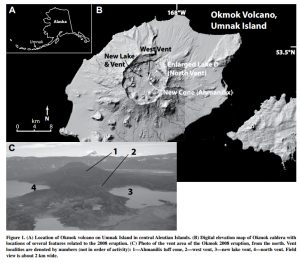
When water interacts with magma, it can dramatically increase the explosivity of the eruption. However, water in the eruption cloud can also increase the rate at which the particles aggregate into larger clumps, allowing them to settle out faster.
The five-week-long 2008 Okmok eruption in the Aleutian Islands of Alaska was explosive due to the interaction of the magma with the abundant water inside the caldera, producing billowing clouds that deposited most of the tephra as fine-grained ash within 10 km of the vent area. The first four hours of the eruption produced coarse tephra that extended well offshore of Umnak Island, but the remainder deposited ash as ash pellets and as muddy rain and mist. This plume scrubbing likely reduced any aviation hazards.
This paper by Joel A. Unema and colleagues describes the stratigraphy, distribution, and grain size, shape, and composition characteristics of the medial to distal deposits of the 2008 Okmok eruption.
These are used to interpret water-magma interactions in the conduit and eruption column, eruption parameters (e.g., volume, column height, mass flux), and fragmentation style. Unema and colleagues then compare the Okmok eruption with the Eyjafjallajökull eruption of 2010.
Reference:
Water-magma interaction and plume processes in the 2008 Okmok eruption, Alaska
J.A. Unema et al., SESES, Box 4099, Northern Arizona University, Flagstaff, Arizona 86011, USA. DOI: 10.1130/B31360.1
Note: The above post is reprinted from materials provided by The Geological Society of America.









